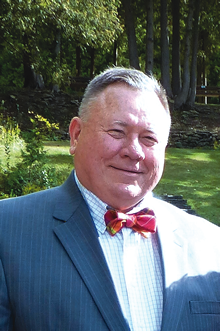California Psychiatrist Helps Develop Integrated Substance Abuse Care
Abstract
Medication-assisted treatment of substance abuse combines medications with counseling and behavioral therapies to provide a “whole-patient” approach to treating substance use disorders.

For more than two decades, Robert Cabaj, M.D., has witnessed the enormous toll that substance abuse exacts on overall health among patients in both primary care and public mental health settings.
He has also seen the effect that fragmentation of service delivery has on patient care—and on overall medical costs: primary care physicians in the past have had few medical interventions for substance abuse and little or no training in how to use those that existed, while psychiatrists have tended to refer patients with substance abuse to specialty clinics.
But today there is a wide array of somatic interventions—along with behavioral strategies and 12-step support groups—for treating substance abuse. And in San Mateo County, Calif., where he is medical director of behavioral health and recovery services, Cabaj has helped to operationalize a set of medical interventions to address substance abuse as a standard of care in all settings in the county’s public-health system.
The result of this systemwide implementation of medication-assisted treatment (MAT) is that patients with substance abuse disorders can be treated by providers in all settings.
“Traditionally, substance abuse has been in the hands of a psychiatrist who specialized in substance abuse; otherwise, no one else treated it,” Cabaj said. “Primary care physicians didn’t really feel like they had effective interventions, beyond counseling and recommending 12-step programs. But today treatment is easy to do, medications are benign, so why shouldn’t both sides of the house of medicine—behavioral health and primary care—treat everyone, regardless of where they present?”
MAT—defined by the Center for Integrated Health Solutions (CIHS) as “the use of pharmacological medications, in combination with counseling and behavioral therapies, to provide a ‘whole-patient’ approach to the treatment of substance use disorders”—is a form of integrated care that is attracting attention nationwide.
In an article on the CIHS website, Elinore McCance-Katz, M.D., Ph.D., chief medical officer of SAMHSA, said that as integrated care becomes the norm, all health care providers, whether in primary care, mental health, or substance use treatment, will need to learn how to provide treatment for disorders they may not have historically treated. “Primary care providers especially will need to be ready to assess and provide treatment for clients who present with mental health and substance use concerns,” she said. “Individuals with chronic relapsing diseases should have access to MAT. It’s just the standard of care.”
In San Mateo County, the effort has fostered a systemwide dialogue and closer collaboration between mental health and primary care. “As primary care doctors have gotten comfortable with these interventions, it became a two-way dialogue,” Cabaj told Psychiatric News. “Now our primary care doctors feel like they can finally address the substance abuse problems they see in their patients, and psychiatrists don’t feel like they need to refer patients to a specialty clinic.”

Robert Cabaj, M.D., says medication-assisted treatment of substance abuse allows patients to be treated for substance abuse in whatever setting they present.
Cabaj brings to the effort a history of trying to standardize treatment of substance abuse across settings. In 1991 he left Boston and came to San Francisco General Hospital, where he was chief consultant on the hospital’s substance abuse consult team.
“It was astonishing—the number of people in the public-health system with substance abuse issues,” he told Psychiatric News. “The vast majority of them were in primary care, and it was very clear that if physicians had some guidelines, they might better address the problems—but without them, they just stepped back and let someone else deal with it.”
So Cabaj created a set of guidelines for treating alcohol and substance abuse disorders and for treating withdrawal. At the same time, one of his staff was doing research on buprenorphine, which was demonstrating superior effectiveness to methadone—an example of a growing number of somatic treatments that would become available.
When he came to San Mateo County three years later, as medical director of behavioral health and recovery services, he witnessed the flip side of fragmented care. “There were all of these people in our behavioral health clinics who had medical care problems,” he said. “I hired nurse practitioners to go into our clinics, and they uncovered loads of untreated medical problems. I started looking into interventions to address those problems, meeting with primary care doctors, and we started to have more joint arrangements across our public health system.”
In 2011, Cabaj began to put together a table of interventions for substance abuse with information on side effects and how medications should be used and under what conditions. Additionally, primary care physicians in the San Mateo public-health system received training in the management of behavioral health conditions—for instance, how to treat chronic pain in the context of substance abuse, how to prescribe medications for ADHD in a way that avoids potential for addiction, and how to use benzodiazepines safely and taper medications when needed.
The effort is producing exciting results, he said. A recent follow-up of 10 patients with severe alcoholism and two or more emergency department visits in the prior month found that treatment with once-a-month injectable naltrexone dramatically reduced craving and increased the number of days of abstinence—while also decreasing overall medical utilization.
Cabaj said that in the initial phase of the pilot, emergency room use practically disappeared, from an initial average of 5.8 visits per client in six months, down to 0.2 visits. In an article on the CIHS website, Cabaj noted that this dramatic reduction shows an evident cost benefit.
“The cost of the medication may be high (for Medicaid clients, the medication costs around $750 per month and exceeds $1,000 per month at retail), but if you can eliminate six ER visits in six months, you save more than enough to cover the cost of the medications,” Cabaj wrote. “In addition to the reduction in emergency services, we have also seen a decrease in the drinking days of participants, and many participants have been able to switch to less expensive oral medication over time.”
Cabaj said that the effort is in keeping with the “triple aim” of accountable care and health care reform—improved outcomes, better patient satisfaction, and lower costs—and he said the successful management of substance abuse allows patients, whether they are seen in primary care clinics or public mental health clinics, to focus on improving overall health
“We started this program as part of our total wellness program, including diet, smoking cessation, and exercise,” he said. “Without the burden of substance abuse, our patients can work on their overall health.” ■



